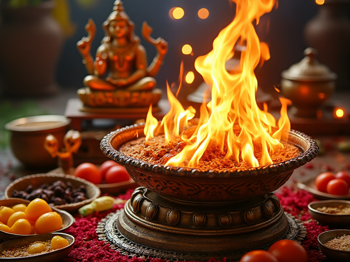The significance of Rahu Dosh Nivarana Pooja lies in its ability to neutralize the negative influences of Rahu. In Vedic astrology, Rahu is known as a shadow planet, and its presence in a horoscope can lead to Rahu Dosh, causing disruptions and challenges in various aspects of life. This pooja is an ancient and revered practice that helps in mitigating the malefic effects of Rahu, promoting mental clarity, spiritual growth, and overall well-being. By performing this pooja, individuals seek to pacify Rahu, reducing his adverse impacts and inviting positive energy, success, and prosperity into their lives.
- Mitigates the malefic effects of Rahu: Helps reduce the negative influence of Rahu in the horoscope, bringing balance and harmony to life.
- Promotes mental peace: Alleviates stress, anxiety, and mental confusion caused by Rahu’s influence, promoting peace of mind.
- Enhances financial stability: Helps overcome financial challenges and attract prosperity and abundance.
- Improves health: Aids in the prevention and recovery from health issues associated with Rahu's malefic placement.
- Strengthens relationships: Reduces misunderstandings and conflicts in relationships, fostering harmony in personal and professional life.
- Spiritual growth: Promotes spiritual awareness and growth, helping individuals to connect with their higher self.
- Removes obstacles: Helps in overcoming unexpected obstacles and challenges in life, paving the way for success.
- Increases self-confidence: Boosts self-confidence and courage to face challenges and make sound decisions.
- Protection from negative energies: Shields against negative energies, black magic, and evil influences associated with Rahu.
- Fulfills desires and aspirations: Assists in the fulfillment of desires and achieving goals with the blessings of Rahu.
Step-by-Step Procedure to Perform Rahu Dosh Nivarana Pooja
Performing the Rahu Dosh Nivarana Pooja requires careful preparation and adherence to Vedic rituals. Below is a step-by-step guide to conducting the pooja:
1. Preparation Before the Pooja
- Choose an Auspicious Day: Consult a qualified astrologer or refer to the Panchang (Hindu calendar) to select an auspicious day and time for the pooja, preferably on a Saturday or during Rahu Kalam.
- Cleanse the Space: Clean the area where the pooja will be performed. It's best to conduct the pooja in a clean, quiet, and sacred space in your home or at a temple.
- Gather the Required Items:
- Idol or picture of Rahu
- Black cloth
- Sesame seeds (til)
- Black gram (urad dal)
- Blue or black flowers
- Black mustard seeds
- Iron nails or items
- Oil lamp (diya) and incense sticks
- Coconut
- Fruits, sweets, and other offerings
- A mixture of rice, turmeric, and vermilion
- Water and a copper vessel (kalash)
- Personal Preparation:
- Take a bath and wear clean, preferably black or dark-colored clothes.
- Maintain a calm and focused mind, free from distractions.
2. Setting Up the Altar
- Place the Idol or Picture: Place the idol or picture of Rahu on a raised platform or altar covered with a black cloth.
- Arrange the Offerings: Place the sesame seeds, black gram, black mustard seeds, blue/black flowers, fruits, sweets, and coconut around the idol.
- Lighting the Lamp: Light an oil lamp (diya) and incense sticks in front of the altar.
- Kalash Setup: Fill the copper vessel (kalash) with water, place a coconut on top of it, and keep it near the idol.
3. Invocation and Sankalpa
- Invoke the Deities: Begin by invoking Lord Ganesha to remove any obstacles during the pooja. Offer prayers and chant Ganesha mantras.
- Sankalpa (Intention): Take a few moments to state your intention (Sankalpa) for performing the pooja, focusing on mitigating the effects of Rahu Dosh in your life. Recite the Sankalpa aloud, stating your name, the purpose of the pooja, and the desired outcome.
4. Rahu Pooja Rituals
- Aavahan (Invocation of Rahu): Invoke Rahu by chanting the Rahu mantra: "Om Rahuve Namah." Visualize Rahu's presence in the idol or picture.
- Offerings (Upachara):
- Offer black sesame seeds, black gram, black mustard seeds, and iron items to Rahu.
- Place blue or black flowers on the idol or picture.
- Offer fruits, sweets, and coconut as naivedya (food offering).
- Abhishekam (Holy Bath):
- Perform Abhishekam by pouring water over the idol or picture, chanting the Rahu mantra.
- After Abhishekam, gently wipe the idol or picture with a clean cloth.
- Arti (Waving of Light): Perform Arti by waving the lit oil lamp in a circular motion in front of the idol or picture, accompanied by the chanting of Rahu mantras.
- Pradakshina (Circumambulation): Perform three or seven circumambulations around the altar, meditating on Rahu and seeking his blessings.
5. Rahu Mantra Recitation
- Recite the Rahu Beej Mantra ("Om Bhram Bhreem Bhroum Sah Rahave Namah") 108 times, using a Rudraksha mala if available.
6. Prayers and Conclusion
- Final Prayers: Offer final prayers to Rahu, expressing gratitude for his blessings and requesting the removal of all obstacles and negativity from your life.
- Visarjan (Concluding Ritual): Conclude the pooja by mentally thanking Rahu and respectfully requesting him to depart.
- Distribution of Prasadam: Distribute the fruits, sweets, and other offerings as prasadam (blessed food) to family members and participants.
7. Post-Pooja Rituals
- Donation and Charity: It is recommended to donate black items, such as black clothes, sesame seeds, or iron, to the needy. Performing acts of charity on this day enhances the positive effects of the pooja.
- Maintain Piety: After the pooja, maintain a peaceful and pious demeanor for the rest of the day. It is advisable to refrain from consuming alcohol, non-vegetarian food, and other tamasic foods.
By following these steps with devotion and sincerity, the Rahu Dosh Nivarana Pooja can help mitigate the malefic effects of Rahu and bring peace, prosperity, and protection into your life.




